Profile
Leighan Falley’s Great Heights
First published in issue 16.2 of The Ski Journal.
To ride with Leighan through her backyard mountain range redefines the concept of joy in motion. As we bob and weave through unforgiving terrain, it’s clear that for Leighan, flight connects her to the surrounding peaks. But her creativity extends well beyond the skies—an accomplished skier, alpinist, painter and mother, she’s become an integral part of Alaska’s mountain community, a natural force all her own.
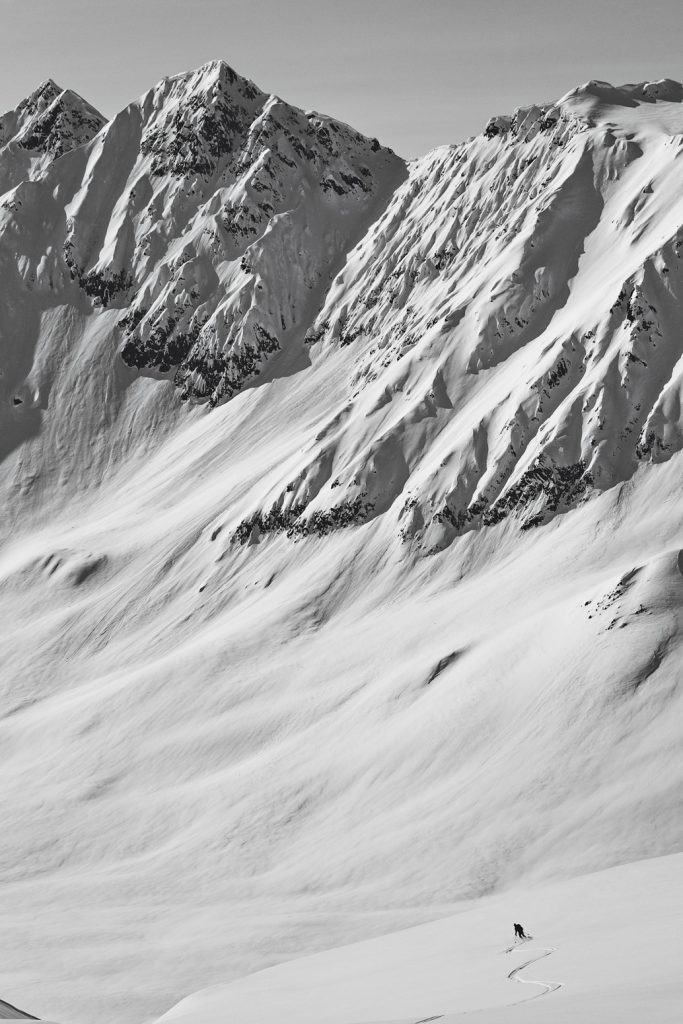
Leighan noodles through new snow on a small glacier in the southern Alaska Range, testing stability in mellow terrain before stepping to higher, steeper and more consequential lines after a new storm. Though the snow was perfect powder when we landed, it quickly began to heat up, foiling our plans for a longer ski day.
It’s a sunny Monday in late March and the sleepy town of Talkeetna, AK, remains buried under three feet of snow. On a frozen lake on the outskirts of town, Leighan stacks our skis into the back of her two-seater plane and grins at me. “I think ski flying is my favorite thing in the world,” she gushes. “It’s a combination of the two things I love most.”
Leighan is striking, with hazel eyes that reflect the morning sun. The 41-year-old laughs as she shows off the hair dryer that keeps her plane’s engine oil from freezing and points out that her engine blanket is sewn from an old mountaineering tent fly—a relic of past expeditions in the Alaska Range. During her early days as a Denali guide, Leighan earned the nickname “the Raven” thanks to her uncanny imitation of a raven’s call. Her dark hair and clothing reinforce the moniker, which took on new meaning when she left guiding and began flying. Her now-thriving career as a glacier pilot for Talkeetna Air Taxi has earned her a fabled reputation among Alaska Range climbers and skiers, who she shuttles to various base camps throughout the range each spring.
Born into a flying family, one of Leighan’s earliest memories involves her dad’s plane. “I remember being strapped in a car seat in the back of the plane and loving it,” she says. But as a child, she never imagined becoming a pilot. “I was a very timid and unmechanical child,” she admits. “So I never thought I was pilot material, but I always had a burning desire to fly.”
Growing up in Fairbanks, AK, Leighan was drawn to the imposing Alaska Range. An artist from a young age, she was obsessed with the jagged form they cut across the horizon and was inspired by the “power of the landscape.” She skied Nordic until picking up downhill skiing in college and spent the next decade working as a liftie and ski patroller in Colorado and Utah. Summers were spent guiding Denali climbs and rafting trips in Alaska, but those two worlds collided over a few springs spent living out of a van on Thompson Pass, where she cut her teeth among heli guides and pro skiers in the steeps surrounding Valdez, AK.
During this formative period, Leighan racked up a long list of impressive descents across the state, skiing off the summit of Denali and ticking off a solo mission to ski Meteorite Peak, which is listed in Fifty Classic Ski Descents of North America. Climbing and skiing big, remote lines under human power became a tenet of her identity. “It made me feel alive and connected with the mountain,” she says. “I felt called to ski off the zenith features. They’re these beautiful, hostile expressions of nature, and I just wanted to find out what they were made of and what I was made of.”
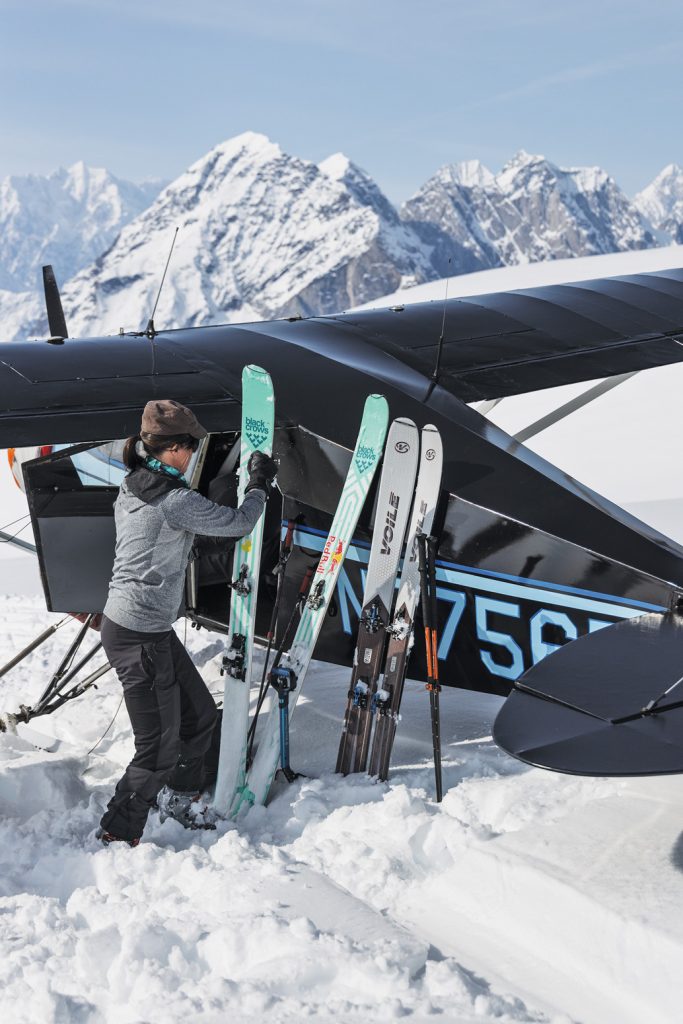
Leighan scrapes the snow from our skis before loading them into her Piper Pacer. Shoving the skis into the back of this tiny aircraft takes a bit of muscle and maneuvering.
One summer in her early 20s, a climbing expedition in the Alaska Range drove Leighan to finally pursue the power of flight. After a long week spent exploring the Ruth Gorge, her team helped their air taxi pilot dig his plane out of the snow—a slow, grueling task. As a token of gratitude, he gave the climbers a long tour of the range on their flight back to Talkeetna. The detour left Leighan glued to the window. “I decided right then and there that I had to become a glacier pilot,” she says.
Later that summer, Leighan suffered a foot injury that ended her guiding season early. She decided to spend every penny she had on flight school, training for her private pilot’s license with an instructor in Talkeetna. Driven by the possibilities of far-flung adventures in the mountains, she expedited the process, completing ground school and the required 40-plus hours of instructor flight time in just two months. “I wanted to have my own free will to access the range to go skiing or climbing,” she says. “I’ve been obsessed with the Alaska Range since I was little and combining that love with the ability to fly around within it—I had to make it a larger part of my life.”
Leighan eventually settled in Talkeetna and started a family with her husband Tucker Chenoweth, a former ski patroller she’d met while “skiing too fast” during her stint as a liftie at Eldora Mountain. The town in the shadow of the Alaska Range would become a fantastic place to raise two girls while pursuing rugged ski adventures and mountain careers (Tucker now serves as the south district ranger for Denali National Park).
While developing her skills as a mountain pilot in the early 2000s, Leighan’s background as a ski patroller, avalanche educator and mountain guide gave her a unique advantage. Glacier flying comes with distinct challenges—newer glacier pilots often get stuck in difficult snow and have to spend the night out, or get heli-evacuated in extreme circumstances. You need to know a lot about snow to fly a ski plane. “It’s very, very tricky to judge from the air,” she says. “The Inuit have 36 words for snow…and I feel like I’ve seen every single one in one day of ski flying.”
Following the lead of local backcountry ski pilots like Talkeetna’s Paul Roderick, Leighan became the lone female pilot among a small group who regularly accessed the Alaska Range for ski tours after work. While Talkeetna has very little ski terrain within driving distance, a short flight to the range holds endless possibilities—from steep, loaded chutes to mellow, scenic glacier runs. Many of the glaciers are unnamed and most of the terrain is unknown to the general public—a perfect haven for skiers seeking solitude.
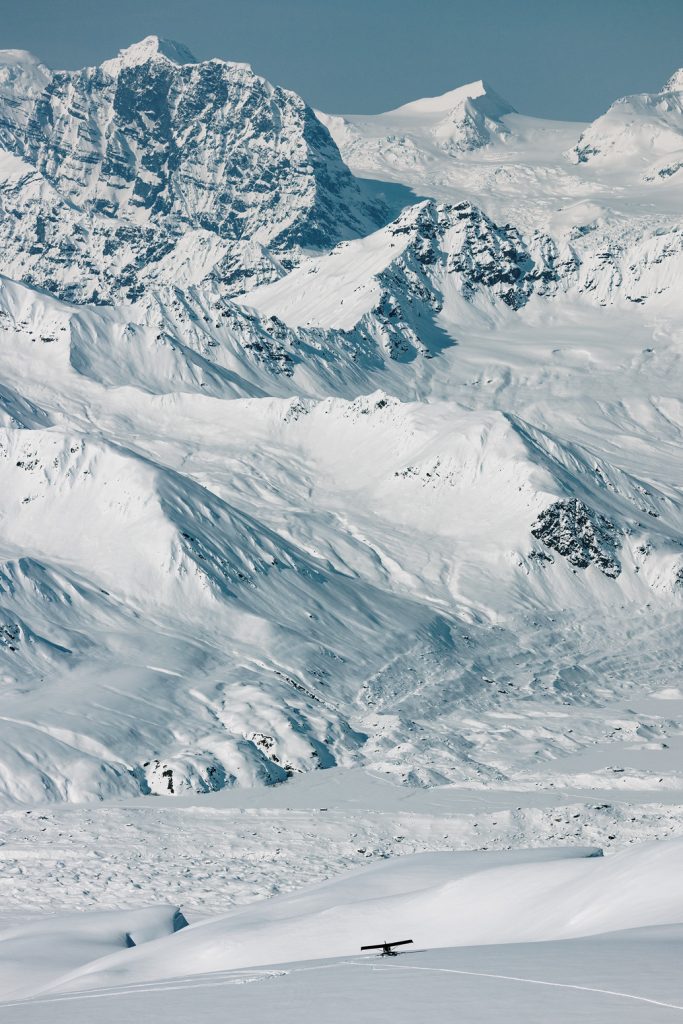
Leighan’s plane is dwarfed by the towering peaks of the Alaska Range. Our skin track is visible at the bottom of the frame, winding through a cacophony of rock and tumbling ice.
Recreational ski flying has gained popularity recently among Alaskans, and more and more skiers are using scrappy personal planes to avoid crowds and expand available terrain. “People used to mainly use bush planes to transport goods from point A to point B. Very few pilots were using their planes to access the backcountry,” Leighan explains. While she was among some of the earlier recreational ski pilots, she says an expanding group of young, athletic pilots is now approaching flying from a backcountry skier’s perspective. “It’s really fun to see how outdoor athletes take on the art of flying from the other side,” she says. She describes the growth as a “backcountry ski renaissance,” broadening the realm of possibility for backcountry skiers in Alaska.
Many of these emerging ski pilots are women, a sign of a shifting culture in backcountry aviation. Once the lone woman in a field of men, Leighan now feels like “there’s an army at [her] back.” Meg Smith, who started flying just over three years ago, looked up to Leighan as an accomplished backcountry skier upon moving to Alaska in 2011. Since obtaining her pilot’s license, Meg has flown and skied remote corners of the Chugach where few have laid tracks. While she’d dreamed of flying since childhood, recreational pilots in Alaska opened her eyes to what she could accomplish with her own bush plane. “Leighan was doing such cool things with her plane,” Meg says. “I thought, ‘That’s what I want to do. Talk about writing your own story.’”
As Leighan juggles her demanding career with being a mother to her two daughters, Scout and Skye, her personal plane serves as a line to the activities she loves most. Alaska Range pilots often work 14-hour days during the busy season, with unpredictable schedules dictated by weather and constantly changing conditions. Annual pilot-recurrent training coincides with spring climbing season, meaning workdays are jam-packed from April into the summer. But Talkeetna Air Taxi ensures two days off a week for their pilots, allowing important respite from the demands of work. During summer weekends, Leighan often flies her 4- and 9-year-old girls out for remote camping trips, and in the winter she sneaks away for solo ski missions as often as she can. Days spent touring alone in the mountains serve as a mental reset for Leighan. While she still seeks plenty of steep skiing, many of her solo days are spent on mellower terrain. “Being a big mountain skier was my entire identity before I had children,” she explains. “I don’t have to ski off Meteorite anymore—I love gardening with my children, flying around in the jagged mountains, and getting out to ski when I can. I feel like I’ve lived a dozen people’s lifetimes.”
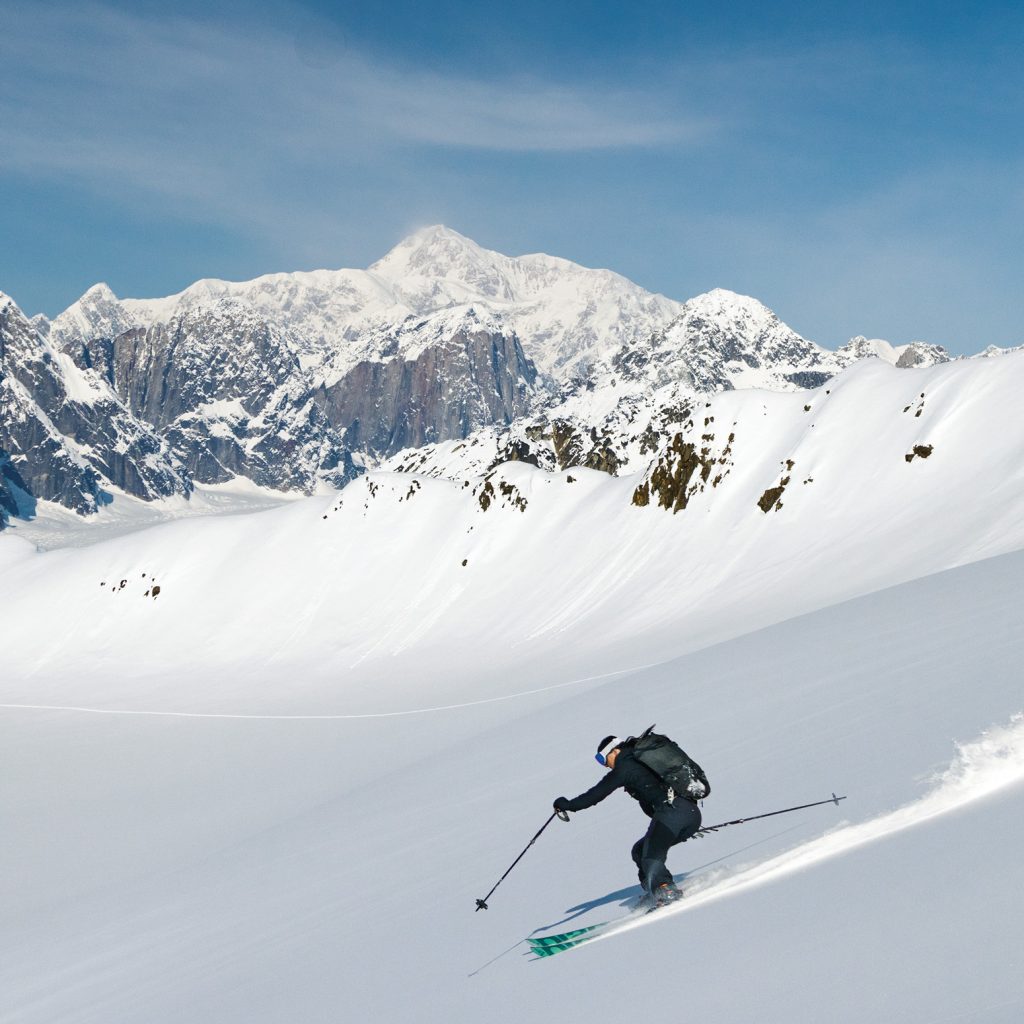
Leighan samples fresh snow in the foothills of the Alaska Range, framed by Denali and the Great Gorge of the Ruth Glacier in the background.
As we approach the foothills of the Alaska Range, Leighan points out some of her favorite ski zones. Spines and chutes beckon in every direction, but she’ll save those for another day—today’s plan is mellow glacier laps to feel out new snow. Because Leighan and her ski partners often ski untouched zones, she must constantly assess changing snow stability.
“There’s an incredible view of Denali from this glacier,” Leighan tells me as we approach for landing. The glacier is small and sloped, but Leighan executes the landing with ease. Larger ski planes would be unable to land here, but the Pacer’s compact size is perfect for the objective. It was once an unlikely bush plane with an underpowered engine and the wrong landing gear for mountain flying. After an old friend of Leighan’s imported the plane from California, a talented female mechanic in Talkeetna named Danial Doty spent a month modifying it into the machine it is today. We wriggle out of the tiny plane into soft, boot-top powder as a symphony of towering peaks, tumbling glaciers and golden rock walls welcomes us to our own private show. There’s not a single ski track in sight. Leighan points out a few familiar summits as we prep our touring gear, noting some that she’s climbed and some that she’s painted.
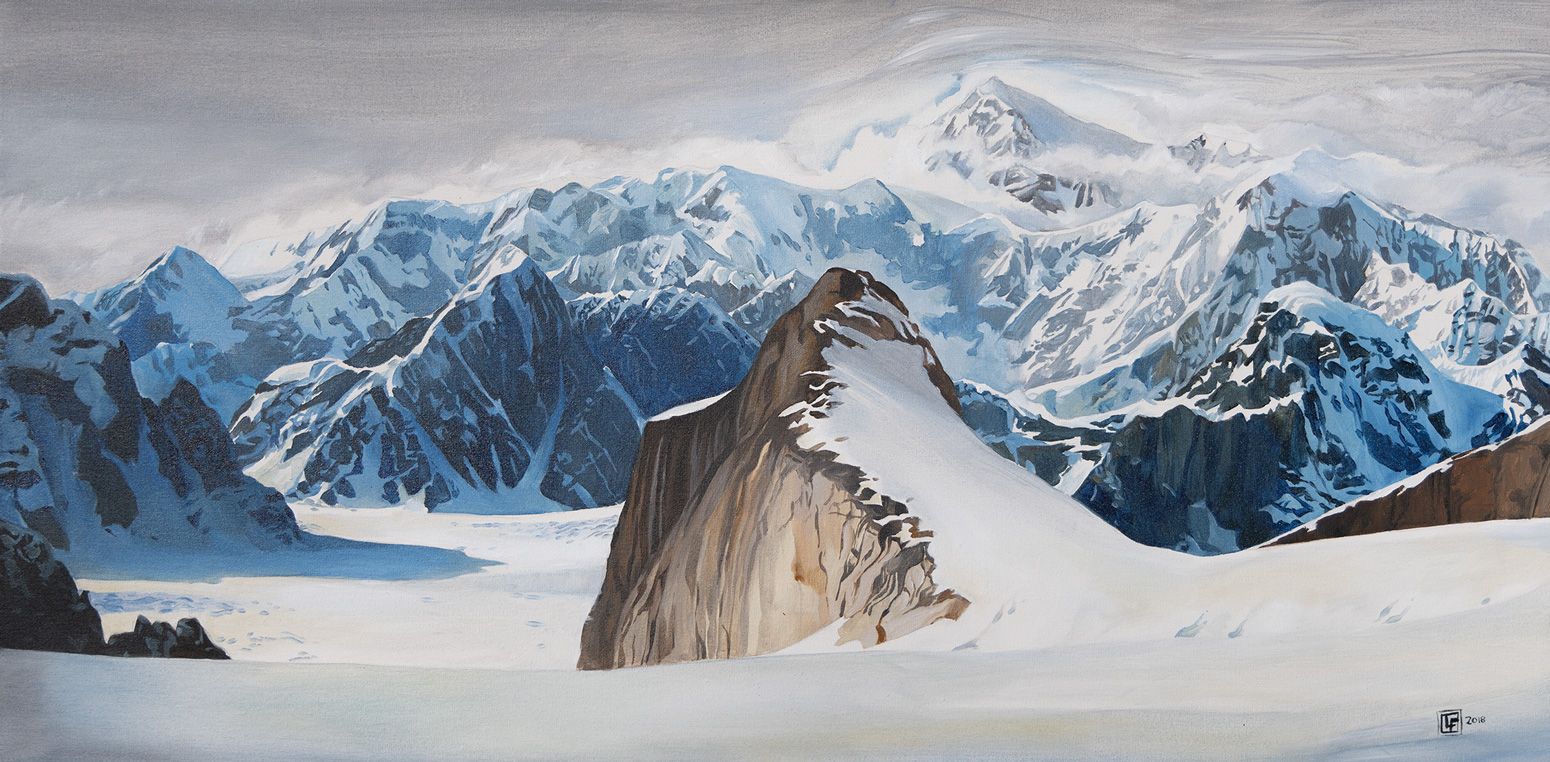
“Denali as Seen from the Root Canal,” acrylic on canvas. Original painting by Leighan Falley.
It’s difficult to separate Leighan’s identity as an artist from her identity as a skier—the spiritual connection that she nourishes in the mountains was first fed as a young girl, painting mountain scenes and eagles taking flight. Painting now serves as an escape from her bustling life in and around those mountains, and also as a connection she can cultivate from the comfort of home.
Leighan’s artistic worldview has a strong influence on her time in the mountains; as much as she seeks quality ski terrain, she also looks for dramatic imagery. In flight, she peers intently around each bend, surveying the composition of the landscape, pulling her phone out for a photo if the lighting or view is particularly striking. Many of these images become references for Leighan’s paintings, which depict ethereal mountain scenes. “[Ski flying] has a directly symbiotic relationship with my art,” she explains. “And the coolest thing is, on a beautiful day, I get to feel like I’m flying around in one of my paintings.”
On the glacier, we shovel soft powder from underneath the plane’s skis to prevent too much settlement. The Pacer’s black exterior is striking against the brilliance of the snow. The color symbolizes the Raven, and the tail numbers—hand-painted by Leighan in turquoise—represent the ice and glaciers she soars above.
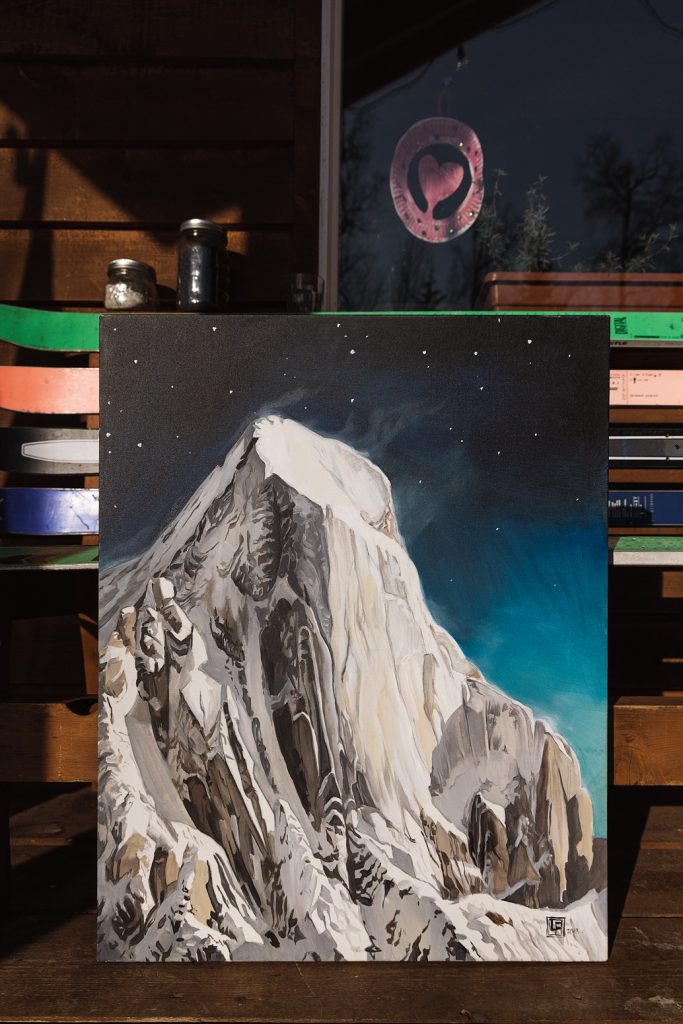
Leighan’s original acrylic painting, “Winter Winds Rake the Broken Tooth,” photographed on her front porch in Talkeetna, AK.
Leighan breaks trail as the plane shrinks from view. Denali, Begguya and Sultana loom in the distance. The golden morning molts into a glaring afternoon and the snow begins to transform, sticking to our skins. Leighan is as comfortable here as she is in the air, blazing uphill at an impressive clip despite her heavy metal touring gear. Her powder skis, handed down by Michelle Parker after Leighan flew Michelle’s crew into the range, still sport a Red Bull sticker.
We only have time for a single lap as the sun works quickly to turn tantalizing powder into gluey mashed potatoes. Leighan prepares me for the full ski-flying experience as we skin back to the plane. “I think we should stomp in a runway,” she says apologetically, laughing about our misfortune. We strip off our layers and skin up and down the glacier for an hour, swapping ski stories and sweating in the March sun. A few planes buzz overhead—Leighan’s colleagues shuttling tourists out toward Denali. They each dip a wing to wave hello, the black plane easily recognizable next to a pair of fresh downhill ski tracks. A bit more shoveling and we’re ready for takeoff. Back in the cockpit, Leighan explains that she will bail if we’re not off the ground by mid-glacier. She starts the engine and the Pacer rumbles to life. Moments later we leave the ground, gliding seamlessly from snow to sky.
